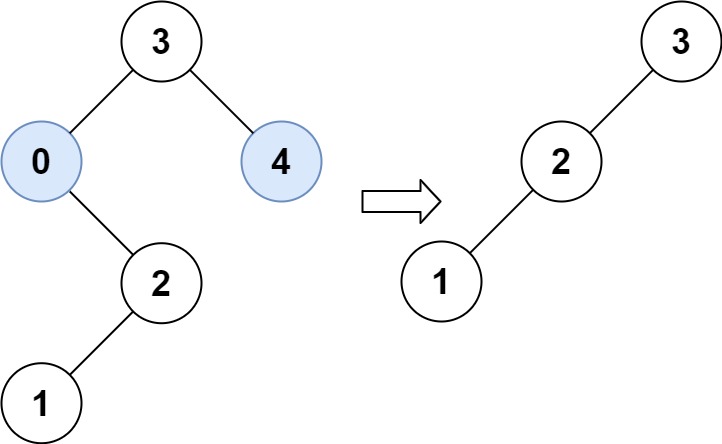leetcode Daily Challenge on Feburary 2nd, 2021.
Difficulty : Medium
Related Topics : Tree、Recursion
Given the
rootof a binary search tree and the lowest and highest boundaries aslowandhigh, trim the tree so that all its elements lies in[low, high]. Trimming the tree should not change the relative structure of the elements that will remain in the tree (i.e., any node's descendant should remain a descendant). It can be proven that there is a unique answer.Return the root of the trimmed binary search tree. Note that the root may change depending on the given bounds.
Input: root = [1,0,2], low = 1, high = 2 Output: [1,null,2]Input: root = [3,0,4,null,2,null,null,1], low = 1, high = 3 Output: [3,2,null,1]Input: root = [1], low = 1, high = 2 Output: [1]Input: root = [1,null,2], low = 1, high = 3 Output: [1,null,2]Input: root = [1,null,2], low = 2, high = 4 Output: [2]
- The number of nodes in the tree in the range
[1, 10^4].0 <= Node.val <= 10^4- The value of each node in the tree is unique.
rootis guaranteed to be a valid binary search tree.0 <= low <= high <= 10^4
- mine
- Java
- Recursion
Runtime: 0 ms, faster than 100.00%, Memory Usage: 39 MB, less than 34.92% of Java online submissionspublic TreeNode trimBST(TreeNode root, int low, int high) { if (root == null) return root; if (root.val < low) return trimBST(root.right, low, high); if (root.val > high) return trimBST(root.left, low, high); root.left = trimBST(root.left, low, root.val); root.right = trimBST(root.right, root.val, high); return root; }
- Recursion
- Java

